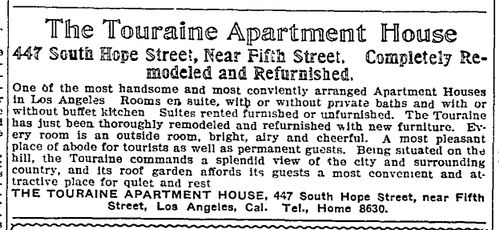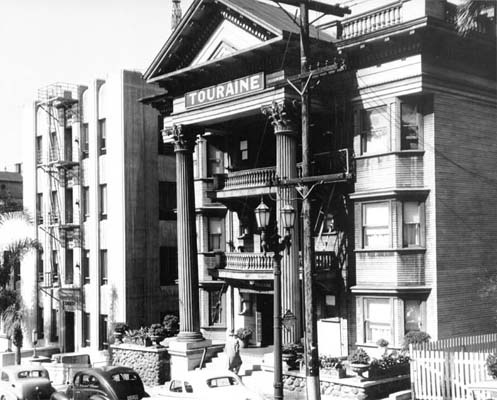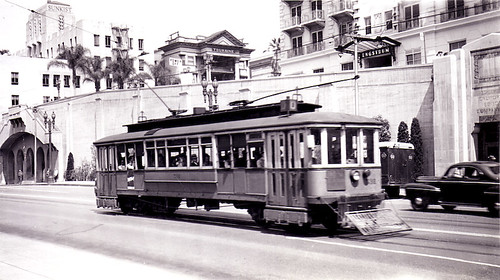
In an era of spacious Victorian mansions, one could argue that the Touraine Apartments on Hope Street were 100 or so years ahead of their time. Erected in 1903 and opened in 1904, the units of this neoclassical building were designed to squeeze in a maximum number of tenants at market rates while presenting the illusion of roomy living quarters. At one point, residents were forcibly driven out in favor of higher renters. Before being demolished in the mid 1960s, the Touraine had survived a couple of fires, a colorful cast of characters, an amnesia inducing accident, and at least one suicide.
Designed by architect A.L. Haley, who was also responsible for the Higgins Building on Main Street, the Touraine’s columned facade stood three stories high, while the rear of the structure was eight stories, sloping with the natural terrain of Bunker Hill. Aimed at attracting wealthy renters, the Touraine’s elegant grand staircase lead up to a large rooftop garden and sun room. Unlike other boarding houses and mansions on the Hill which contained spacious muti-roomed residences, the Touraine’s apartments claimed to have all the functions of seven rooms squeezed into two, plus a kitchen.

According to the Los Angeles Examiner, the floor-plan “shows a parlor, a living room, a kitchen, a private hall, a private bath and a storage closet. Apparently there are no bedrooms or dining room.” The beds actually folded into the wall. One could be disguised as a mantle during the day, the other as a large plate glass mirror. A writing desk and bookcase were built into a door that concealed a large closet and the dining room table could be folded and hung up. The kitchen contained swinging doors with the stove attached, so that once the cooking was done, the door could be swung out into the living room and the stove used as a heater.
The building, which would have traditionally housed six or seven units contained twenty eight. The inventors of the floor plan were so impressed with their design that they patented the plan, as well as the built-in appliances. The gimmick of having the comforts of seven rooms in two was successful, and the Touraine Apartments became a fashionable residence for many wealthy patrons. Apparently, they were not wealthy enough.

The Great Touraine Siege of March 1906 began when hired landlady Estella Palmer collected rent and utility payments from all the tenants and promptly skipped town. Despite having proof of payment, part owner, F.W. Marshall demanded that the residents repay the full amount. Looking to replace the current tenants with higher paying ones, Marshall had no problem turning off the electricity, gas and telephones when the residents refused to double pay. Holding their ground, the tenants lived by candle light and hired lawyers, proclaiming to the Herald newspaper that the landlords “are only waiting the chance to cut off our heads.” When the water was cut, many residents found they could not tolerate the unsanitary conditions, caved in and moved out. For those who refused to move, Marshall took to breaking into their apartments when they were out and removing all their personal belongings. By the end of the weeklong confrontation, all the residents had been forced out. Apparently, tenants rights had not been established at the turn of the century. A local apartment building sought to capitalize on the stand-off by advertising that residents would not be “Tourained” at their establishment. Two months after the incident, the remodeled Touraine re-opened and the owners advertised in the Los Angeles Times for five straight months trying to lure wealthier renters.

During its six decades the Tournaine suffered two fires. The first in 1905 was caused by what the Times described as an “immense pile of rubbish in the storeroom.” The second in 1932 was started when a jilted boyfriend decided to enact revenge on his ex by setting her entire building on fire. Both blazes were minor and resulted in no injuries.
Like any good Bunker Hill boarding house, the Touraine had its fair share of shady dealings. In 1931, a prospective renter parked his car in front of the building while he ran inside to make lodging arrangements, only to have the auto stolen from under his nose. Dr. John Klutho provided the building with its token suicide by shooting himself in his room in 1934. A few months later, Effie Laurelle Doll sued the owners when a routine fumigation made her violently ill. The judge and jury decided they need to visit the building before making a final decision. By 1956 the Touraine’s residents were not as elite as they had once been. This was demonstrated when two tenants were arrested for knocking over a local liquor store.
But, of all the goings on at the Touraine, the most bizarre was the case of Miss Ruby Jester.

Ruby Jester was a Southern Bell who in August 1911 announced her engagement to local aviator and academic Sigurd Russell. Shortly after the announcement, Miss Jester, while living at the Touraine, was knocked unconscious after she fainted at the top of the grand staircase and tumbled down it. When she came to, Ruby was struck with amnesia, and claimed to have forgotten all of 1911. She believed that she was still in Atlanta, didn’t recognize her surroundings or neighbors, and, even worse, had no clue who her fiancee was! Less than a month after getting engaged to Sigurd Russell, she was indeed married…but not to Russell. Instead, she wed Jack Tilford, her childhood sweetheart whom she clearly remembered. According to the LA Times, dejected Russell “holds no ill will towards his successful rival. He wished them both all happiness.”
By 1939, the 28 efficient apartments had been divided into 56 units. By 1964 the Touraine was gone.
Top photo courtesy of the Los Angeles Public Library Photo Collection


